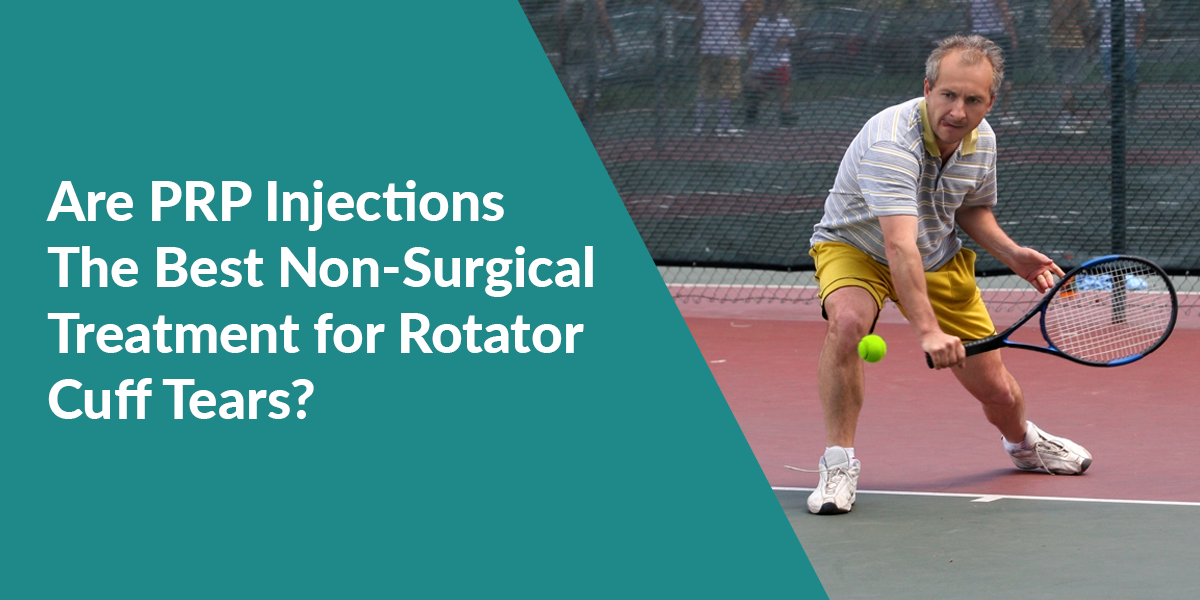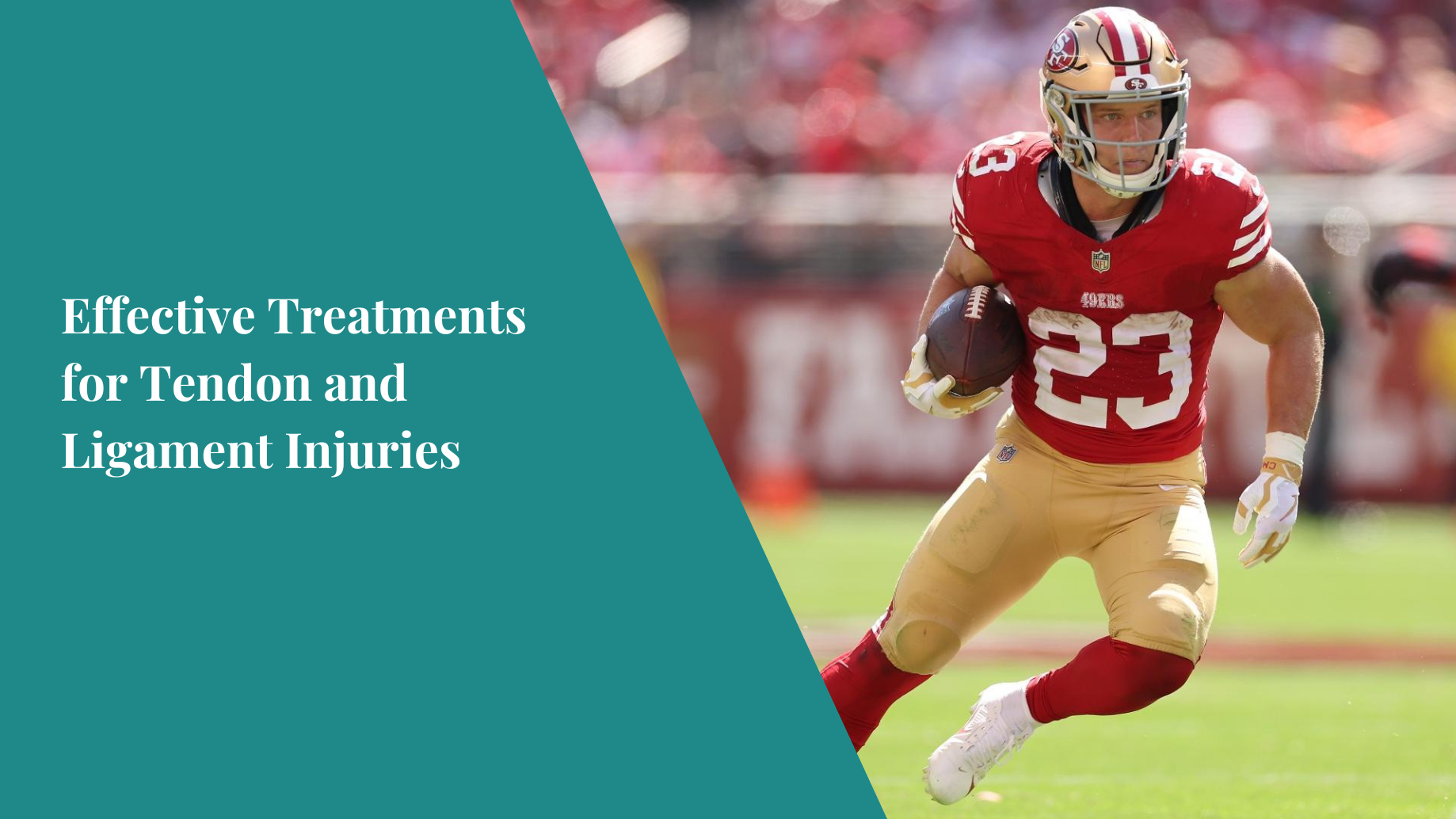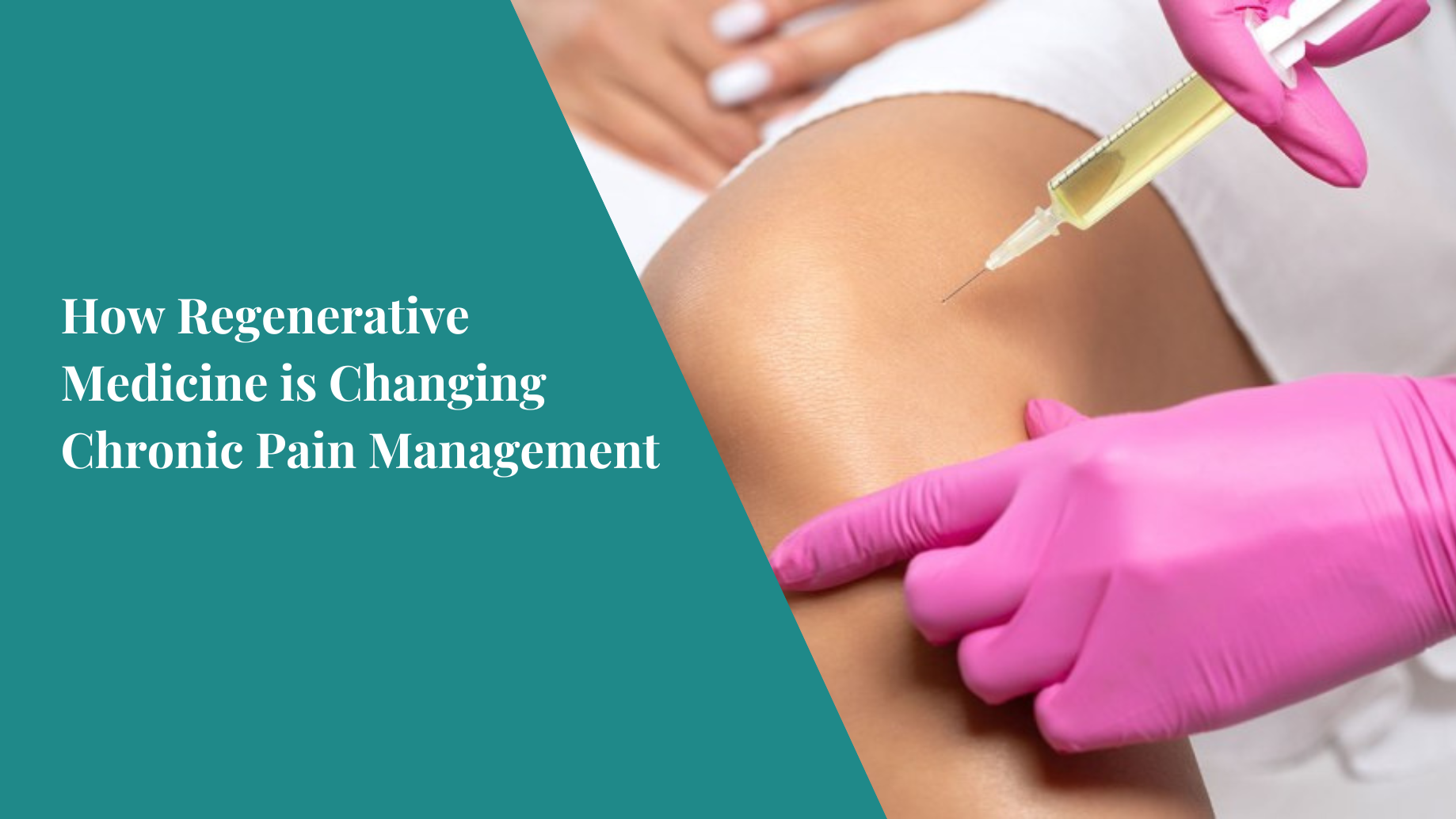Tendon and ligament injuries, such as Achilles tendonitis, tennis elbow, and rotator cuff strains, can…

PRP Injections: The Best Non-Surgical Treatment for Rotator Cuff Tears?
Rotator cuff injuries are a common cause of chronic pain and injury among many adults. Every year, nearly 2 million Americans visit their doctor in relation to problems associated with their rotator cuff.
Without proper treatment, this type of injury could cause weakness in the shoulder and issues with many daily activities. It may become difficult to comb your hair, to get dressed, or even to simply use your computer.
Typically, we hear about rotator cuff injuries happening in athletes or people who have jobs that require repeated overhead motion. In reality, though, rotator cuff tears are largely caused by the normal wear and tear that goes along with aging, which means being over 40 puts you at greater risk.
Surgery, physical therapy and cortisone injections are the most common treatments to treat shoulder tendon and muscle injuries.
However, we have seen evidence that a relatively unknown and emerging treatment can be much more effective, not only in treating the rotator cuff, but also in healing the patient’s pain.
That treatment is something we talk a lot about here at the Tolbert Center: platelet-rich plasma injections. Here’s what you need to know.
Rotator cuff injuries: What you need to know
What is the rotator cuff?
You’ll find your rotator cuff in your shoulder, as this name refers to a group of muscles and tendons surrounding your shoulder joint. These soft tissues keep the head of your upper arm bone secured within the shoulder socket, and they aid movement of your arm by allowing it to rotate up, back and around from the security of the joint itself.
What is rotator cuff tendonitis?
Because of the way in which the joint is built, the tendons of the rotator cuff pass under a bony area as they stretch to attach to the arm bone itself. Inflammation to these tendons, which can be caused for a number of reasons, can make them rub and become frayed as they pass between the two bones. Over time, this can cause them to become weak and narrow, and in the case of a person who has grown a bone spur, the issue could become even worse.
The cause of rotator cuff tendonitis (RCT) can be related to your lifestyle, your job or even just something as simple as your age. Some of the most common causes of RCT include:
- Having arms in one position for long periods of time—for example, when using a computer, doing hairdressing or working on a production line
- Having the arm overhead very frequently, as would be required by professional painters, decorators, plasterers or carpenters
- Playing particular types of sports that require an overhead movement of the arm, such as tennis, swimming, weightlifting or badminton
- Sleeping on the same arm every night
- Suffering a rotator cuff tear
- Years of poor posture
- Age
If you are suffering with rotator cuff tendonitis, you might be experiencing varying degrees of pain, depending on what you are doing. In the early stages, your pain will often be associated with lifting your arms, maybe to reach up to high shelves or when elevating your arms to the sides. Brushing your hair might become challenging, as will racquet sports and reaching activities.
Typically, the pain from rotator cuff tendonitis will stop before it reaches the elbow. If you have discomfort that extends into the lower arm or hand, you should talk to Dr. Tolbert as it may be caused by a trapped nerve in your neck or it may require another diagnosis. If you’ve been suffering for some time, you might find that resting in your bed at night is also uncomfortable and that you have stiffness or a loss of movement in your arm. Either way, it’s time to see the doctor and obtain a proper diagnosis.
Diagnosing rotator cuff injuries
Strangely, not all shoulder pain is actually caused by problems with the shoulder. Pain from heart problems, the gallbladder or the diaphragm can also manifest in the shoulder, so it’s important to figure out what exactly is going on before diagnosing RCT. In general, pain caused by the rotator cuff gets worse with movement, and it will get worse—as opposed to better—over time.
Is there an alternative to rotator cuff surgery?
Historically, the only failsafe treatment for rotator cuff injuries have involved invasive, surgical techniques. However, modern developments have brought to the table other options for patients, specifically regenerative medicine such as platelet rich plasma injections, known as PRP.
In studies, PRP injections have been found to be a safe and cost-effective treatment for RCT. In pilot studies, this sort of treatment has been shown to result in improvements to pain, function and tendon pathology, and it should be a realistic alternative for people suffering from rotator cuff injuries.
At the Tolbert Center, we use PRP injections to treat rotator cuff tears because we know your body is capable of healing itself. Need proof? Just think about the last time you cut yourself.
Using PRP, we are able to help your body repair and heal itself after serious injuries that cause injured tendons, cartilage and ligaments in your shoulder.
The procedure is quick and simple too.
A patient is often able to get a same-day exam and consultation with Dr. Tolbert and her rehabilitation team. There is no waiting around for the procedure, therapy or other treatments that might be required. There is also no pre-authorization involved.
Additionally, Dr. Tolbert provides same-day ultrasound exams to guide all procedures so that you can take a look inside your shoulder joint and discuss what’s really going on with your tendons and ligaments.
What is PRP?
Platelet rich plasma therapy (PRP) is a noninvasive, groundbreaking treatment that works to relive pain by promoting the natural healing and long-lasting repair of soft tissues and musculoskeletal conditions. PRP can be used to treat a variety of disorders, including arthritis, tendonitis and rotator cuff injuries.
How does it work?
PRP is a very simple procedure which uses your own blood to provide a healing medium. A small amount of blood is collected from your own supply, usually via your arm. The blood is spun in a centrifuge, which serves to concentrate the platelets, which are the parts of your blood known to stimulate healing.
This concentrated mixture of your own blood cells is then directly introduced into the area of concern, using ultrasound guidance to take it to the very source of the problem. If you have a tear, whether partial or complete, the ultrasound guidance of your doctor will ensure that these healing cells are delivered at the precise point where healing is required.
The process is known as “regenerative medicine,” and it makes perfect sense. It’s a non-chemical, noninvasive method of helping your own body to be the very best it can be. It’s delivering your very best -built-in healing mechanisms directly to the site of injury, to accelerate the healing process and relieve your pain. But does it really work?
Pros and cons of PRP
Our preliminary data at the Tolbert Center shows that 0% of RCT patients who had received PRP treatment sought additional surgery following their procedure. In fact, one of our patients who was 70 years old was able to cancel his shoulder surgery and return to the gym with no pain. We continue to study our patients who receive our regenerative treatments in order to determine what is best for individual patients.
- Pros: If cost is a consideration, which it is for the majority of us, then the cost of PRP treatment pales in comparison with full surgery costs. The actual cost will depend on where you live. As an example, in the Los Angeles area, an RCT surgery will cost in the region of $8,000, as opposed to about $900 for PRP treatment. In comparison to invasive surgery, platelet rich plasma treatment carries a much lower risk of infection and requires zero anesthetic administration. This can make it more accessible for those with heart conditions and other problems that prevent the administration of a general anesthetic. In trials, PRP has shown to produce accelerated and enhanced healing of tendons in many RCT patients.
- Cons: Certain reports have found that PRP does not make a significant difference to certain forms of rotator cuff tears. However, many of these cases involve full tears, which would not necessarily be resolved with this treatment. A 2011 study that followed recipients of a PRP trial over a two-year period found that those with a smaller tear retraction experienced significantly expedited cuff rotator healing, compared to traditional methods. This is Dr. Tolbert’s experience as well. So the sooner treatment is sought after, the better. Don’t wait for your injury to progress.
Because PRP is such a new and innovative procedure, many doctors and specialists shy away from recommending this course of treatment. However, in Dr. Tolbert’s experience with over 200 cases, the benefits of this therapy far outweigh the drawbacks, and the results can be nothing short of amazing.
Bottom line: Get treatment early. Avoid surgery and downtime. Schedule an appointment today to see if you are a candidate for PRP treatment and learn about the Tolbert Method.
The Tolbert Center for Rehabilitation and Wellness is a Los Angeles-area state-of-the-art medical facility specializing in using non-surgical and minimally invasive techniques and procedures for the management of chronic pain. Dr. Glenna Tolbert, the founder of the center, is Board Certified in Physical Medicine and Rehabilitation, with a sub-specialty in Spinal Cord Medicine. Dr. Tolbert believes in a holistic approach to healthcare, where the physician, team of specialists and patients work in partnership to restore the quality of life to each patient. To learn how you can treat a number of chronic pain conditions for less money than it takes to have a spa day, check out our pricing at DrGlennaTolbert.com.
Comments (8)
Comments are closed.




Thanks for the explanation on PRP treatment. Your explanation is well on PRP treatment.
PRP injection helps us to recover fastly from injury. This information is good for us.
[…] PRP (platelet-rich plasma) shots are a type of regenerative medicine. But we’re able to use your own blood to help with healing wounds after surgery, healing cartilage and healing torn tendons. […]
Do you take insurance if so which ones do you take and which ones don’t you take, also I live in Michigan do you have any centers here? If not will you open one here?
It would seem that if a minimal tear is being caused by a bone spur, PRP would be a good post surgical treatment after the spur is removed and the bone has been resurfaced. Are insurance companies paying for the above treatment situation? Is PRP being paid for by Aetna medicare as an alternative or postsurgical treatment for rotator cuff surgery.
The bone spur is the visible end stage sign of chronic inflammation. It’s best to treat/heal the invisible underlying inflammatory lesion early non-surgically, preventing or mitigating the spur.
The spur is a late sign not the cause.
I’ve been told some Workers Comp. insurance pays for PRP, but not my experience.
– Dr. Tolbert
Dr. Tolbert
I have torn rotator cuff tear that is very painfully, especially laying down at night.
I reside in metro Atlanta, GA, are there and any doctors in this area trained to perform your PRP procedure? If so would provide me their contact information? If not, how can I arrange for you exam my specific situation and determine if I am a good candidate for this procedure?
A
Unfortunately, I have no referrals in Georgia.
– Dr. Tolbert